Spanish destroyers: Pioneers
From Audaz to Alvaro de Bazan:
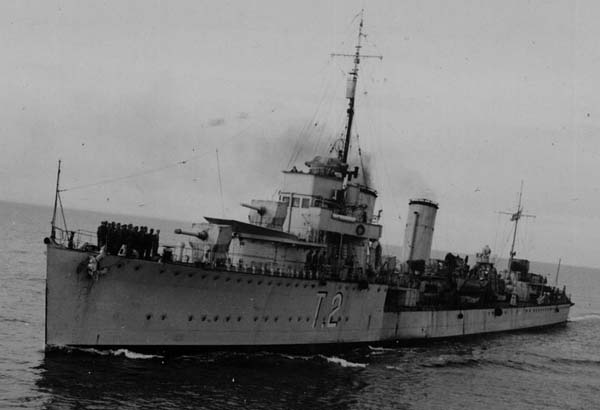
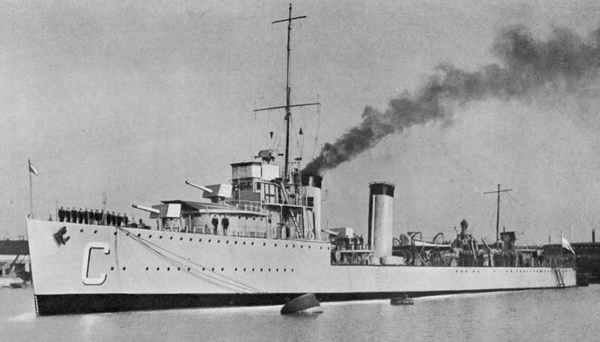
Argentine ARA Juan de Garay & Cevantes of the Churucca class (1926)
Agreed: Audaz is only arguably the very first destroyer, and Alvaro de Bazan was a frigate, although of the size and capabilities of a destroyer. Anyway, this a tradition spanning from 1885 to this day, of destroyers built in Spain. There is no ww1 Spanish destroyer section planned for the close future, so this post will start with these early development, prior to WW1, and WW1 Spanish destroyers as well.

HD Profile of the Churruca class (Conway’s)
The bulk of this subject is to cover Spanish destroyers types, with a short overview of their armament. There will be nothing on tactics since they differed little from that of the Royal Navy prior to WW2. For actions, see the generic WW2 Spanish Navy for battle actions involving Spanish destroyers; A short overview of their career is also part of each study.
An Iberian flair for innovation
There are several fields that were explored by talented engineers and inventors over the years in Spain:
-The invention of the submarine is shared by Spain with a few other nations but Ictineo was the first ever to feature an Air independent steam engine, by Narcís Monturiol, and Isaac peral the first electric submarine. For more see the Spanish Submarines page.
-Spain also invented the autogyro, and ancestor of the helicopter, and also invented the first helicopter-carrier (Dedalo).
-Spain invented the Steam engine by Jerónimo de Ayanz y Beaumont
-And Spain invented the destroyer for what we are concerned for…
Vilaamil’s destructor
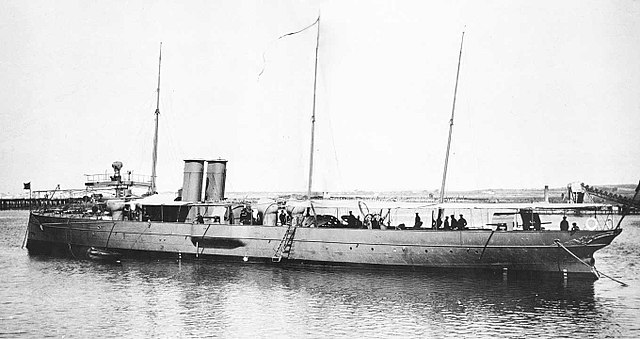
Technically, the Destructor was ordered by the Spanish government in 1885 to UK yards as a torpedo gunboat. She was specifically tailored to hunt enemy torpedo boats, the new threat for larger ships, cruisers and ironclads. The idea came from Fernando Villaamil, second officer of the Ministry of the Navy. He designed his own design of a large torpedo gunboat to search and destroy torpedo boat and protect the Armada.
Since UK was recognised for her expertise in light fast ships, he deposed a tender to several British shipyards and received proposals based on his specifications. In 1885 James and George Thomson of Clydebank won the contest and started the construction of “Destructor” (or “destroyer” in Spanish, one of the two possible origin of “Destroyer” with the British “TBD”). She was laid down at the end 1885 and late 1886, to be fitted out, trialled and commissioned in 1887.
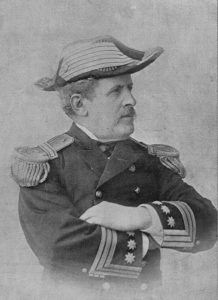 Vilaamil was born from a wealthy nobles and landowners of Asturias (northern industrial Spain). However impoverished, he pursued a career in the Armada, which soon propelled him to higher rank, and ultimately the ministry. Apart the destructor and development of destroyers in Spain, he became a strong advocate of worldwide oceanic sailing as the best training for cadets and embarked in the first onboard the Corvette Nautilus in 1892-1894.
Vilaamil was born from a wealthy nobles and landowners of Asturias (northern industrial Spain). However impoverished, he pursued a career in the Armada, which soon propelled him to higher rank, and ultimately the ministry. Apart the destructor and development of destroyers in Spain, he became a strong advocate of worldwide oceanic sailing as the best training for cadets and embarked in the first onboard the Corvette Nautilus in 1892-1894.
Visiting Cramp in the USA he soon was aware of adopting the latest naval innovations back in Spain. Not heard, his predictions were realized during the abysmal performances of the Armada in the 1898 Spanish-American war where he commanded the destroyer Furor, where he met his fate.
Destructor, the first destroyer
So what made the destructor (apart her name) the first destroyer or precursor of, and not a torpedo gunboat like so many built in the 1880s ?
The design by Vilaamil himself, which known torpedo gunboats designs of the time, and specifically made a lower, lighter, faster ship. In short, a torpedo gunboat/torpedo boat hybrid.
Destructor displaced 348 tons and what made her unique, was she was the first warship ever equipped with twin triple-expansion engine. They generated 3,784 ihp (2,822 kW), allowing her to reach a top speed of 22.6 knots (41.9 km/h). This made her one of the faster ships in the world in 1888, on par with Thornycroft’s experimental Lighting. But she was much larger, armed with one 90 mm (3.5 in) Spanish-designed Hontoria breech-loading gun and four 57 mm (2.2 in) or 6-pounder Nordenfelt guns, and two 37 mm (1.5 in) (3-pdr) Hotchkiss guns. To this impressive artillery was added two 15-inch (38 cm) Schwartzkopff torpedo tubes with three torpedoes for each, so nine in total. The Destructor was manned 60 officers and sailors.
For gunnery, speed and dimensions, her design left nothing to guessing: Her sole purpose was to hunt down torpedo boats at high seas. Therefore most authors agrees that Destructor was indeed an important precursor, if not the invention of the torpedo boat destroyer. She will be covered by a dedicated post.
Spanish Torpedo Gunboats
Since it’s not the main subject here, were are going to cover the subject quickly.
The Armada acquired the Temerario (1889) and Dona Maria de Molina (1896), which were all operational in 1914. The Destructor was classed officially as a torpedo gunboat, but was closer to destroyers in general shape and capabilities. Spanish TGs were larger and slower, at 562 and 830 tonnes respectively.
Temerario class (1889)
Temerario, Nueva España, Galicia, Marques de Molins, Martin Alonzo Pinzón, Vicente Yáñez Pinzón.
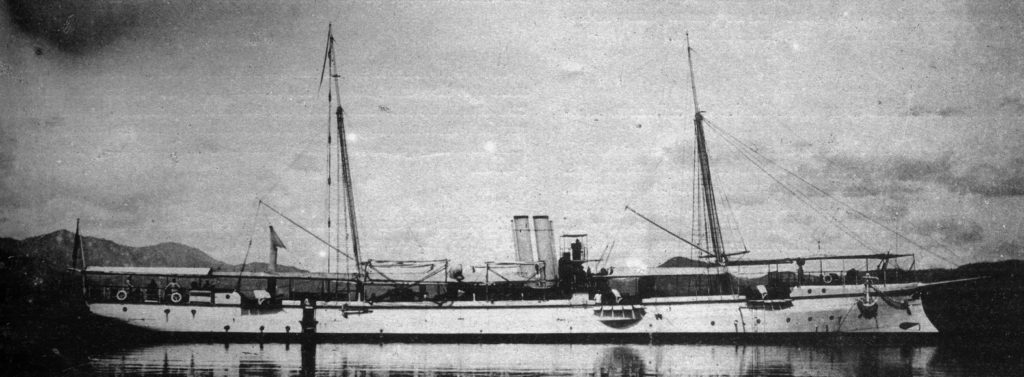
The first was launched at Santa Rosalia, Cartagena, the second at Arsenal de Carraca and all the others at La Graña, Ferrol. The first was laid down in October 1887. Others were launched in 1891-92 and the last, Vicente Yáñez Pinzón, completed in 1894.
These were locally designed and built Steel-hulled torpedo gunboats, with a 13 mm (12.7 mm or ½ inch deck armor) protective deck creating a box over the machinery and boilers. The armament was a mix: They had two 120mm/35 Hontoria M1883 gun fore and aft, and four 57/42 plus four 25/40 Nordenfelt QF guns, they also had two 356 TT with three spare torpedoes for each.
Their powerplant was composed of two vertical triple expansion steam engines rated for 2600 HP total fed by to four boilers, two locomotive and two cylindrical types. Endurance was 3400 nm at 10 knots, on 106 (peacetime) to 190 tonnes (wartime) of coal but top speed as registered on trials was 19 knots.
The Temerario class vessels had a length between perpendiculars of 58 meters, a hull 6.73 meters long with a maximum draft of 3.16 meters and her full displacement, deeply loaded was 630 tons. Standard crew consisted of 91 officers, non-commissioned officers and sailors.
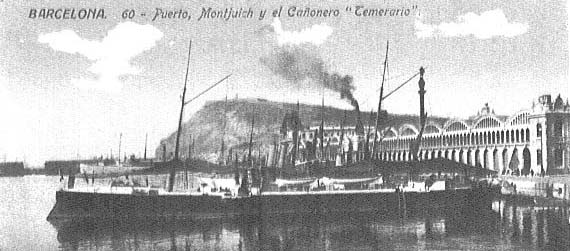
Temerario, postcard
When world war broke out they were barely able to sustain 13 knots, 19 when making sea trials. Their participation in the Hispano-American war wa symbolic. Galicia was sold to Venezuela in September 1898 (Bolivar). In 1918, Marqués de Molins was reboilered, having a single funnel, two 120/35, and four 25mm/40, plus the two original 356 mm TT. Apart Nueva España (ex Velox) which was discarded in 1916, and two Pinzon in 1914 the others were discarded in 1920-22, after WW1.
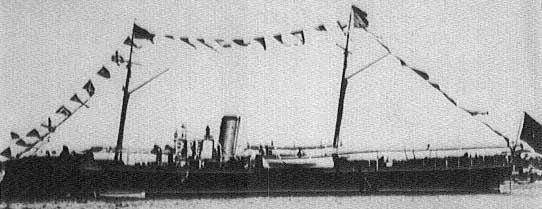
Marques de Molins
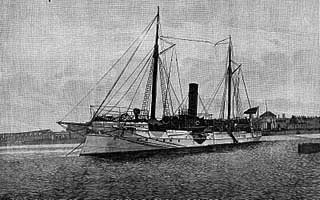 Service
Service
The Temerario class vessels saw some heavy action for some of them: During the 1898 American-Spanish war, Nueva España, Marqués de Molins, Vicente Yáñez Pinzón and Martín Alonso Pinzón and Galicia were stationed in Cuba whereas Temerario stayed in La Plata waters. Nueva España, Galicia and Pinzón skirmished with US Navy ships but were not sunk or badly damaged. After the war Galicia was purchased by Venezuela, in serviceas ARV “Bolívar” and discarded in 1920. The remainder were discarded in 1914 (the two Pinzón) in 1916 for Nueva España, 1920 for Temerario and 1922 for the Marqués de Molins.

Author’s illustration of the Temerario in 1898, previously on cyber-ironclad.com
Specifications:
Displacement: 562 tonnes standard
Dimensions: 58 x 6,76 x 3,16 m
Propulsion: 2 shafts VTE, 4 boilers, 2600 hp, 19 knots.
Armour: Decks and bulkheads 1,5 in.
Armament: Four Hontoria 4,7in (120 mm), four 6pdr (57 mm) QF, one 25 mm Nordenfelt Mg, two 356 mm TT.
Crew: 91
Dona Maria de Molina class (1896)
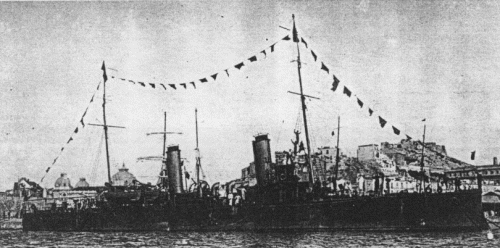
Dona Maria de Molina, Marques de la Vitoria, Don Alvaro de Bazan.
All three torpedo Gunboats were built at La Graña, Ferrol, launched in 1896-97, completed in 1898-1900. They were reasonably Fast torpedo gunboats. After modernization Marqués de la Vitoria had one funnel and María de Molina received two close funnels while Álvaro de Bazán kept her original configuration. The first two were rearmed with two 120mm/35, and four 42mm/42 plus two 57/42 Nordenfelt guns; All three were in Spain during the 1898 war and stayed in service during WW1 and the early interwar, discarded in 1926.
Specifications:
Displacement: 830 tonnes standard
Dimensions: 71.6 x 7,98 x 3 m
Propulsion: 2 shafts VTE, 4 loco boilers, 3500 hp, 19,5 knots.
Armour: Decks and bulkheads 1,5 in, CT 6-in.
Armament: Two Hontoria 4,7in (120mm), four 40 mm Nordenfelt QF, 8 MGs, three 356 mm TTs (one bow).
Crew: 91
Filipinas (1895)

Filipinas – SRC
A single torpedo gunboat for colonial use, built at the Arsenal de Cádiz and completed in 1895. A 747 tonnes, one funnel, 70 x 8.22 m, armed with two 120 mm/35 Hontoria M1883 guns and four 25mm/42 Nordenfelt guns a single 356 TT in the bow plus three trailing tubes. She was propelled two VTE steam engines and four boilers, cranking up 4500 ihp, reaching 20 knots. Endurance was 2000 nautical miles. She was discarded in 1902.
Furor class destroyers (1896)
Furor, Plutón, Terror, Audaz, Osado, Proserpina

Despite Spain became a pioneer of the type, the lack of political will prevented the adoption of destroyers sooner and adoptions of this class somehwat slipped compared to other fleets. The Audaz class became the first operational Spanish destroyer class. They were British-built, at Clydebank NY, and loosely based on the 27 knotters, standard destroyers of that time.
However, as specified by the Spaniards, they were faster and more powerful. The class comprised the the Audaz, Osado, Pluto and Porcupine, were redesigned and leaned towards the “30 knotters”. They were fitted with Normand boilers. Porcupine differed by having wo funnels.
The earlier Furor, Terror and Pluto served with the Cuban squadron and were anchored in Santiago in 1898 when Admiral Schley made his fatal swoop in the. A fierce battle, leaving no chanced to the Spaniards, ended with the destruction of the Furor and Pluton.
The drama of it all was that Fernando Villaamil, which led the DD squadron, knew his destroyers were badly used by Admiral Cervera.
Pluton had a homeric artillery duel with the armed yacht USS Gloucester, which she disabled before being targeted by the guns of larger ships. Terror was the only one to escape from the total destruction of the Admiral Cervera squadron that day, saved by her speed. The others, operating in Spain, did serve in the next war and well beyond. They were converted as minelayers and broken up eventually in 1924-31.

Author’s rendition of Furor in 1898
Specifications
Displacement: 380 tonnes FL
Dimensions: 69,8 x 6,88 x 4 m
Propulsion: 2 shafts 3cyl TE engine, 4 Normand Boilers, 7000 hp, 28 knots.
Armament: Two 3-in (75 mm), two 2-in (57 mm), 2 x 8mm Maxim Mgs, two 14-in (350 mm) TT.
Crew: 65
Bustamante class (1914)
Bustamante, Vilaamil, Cadarso
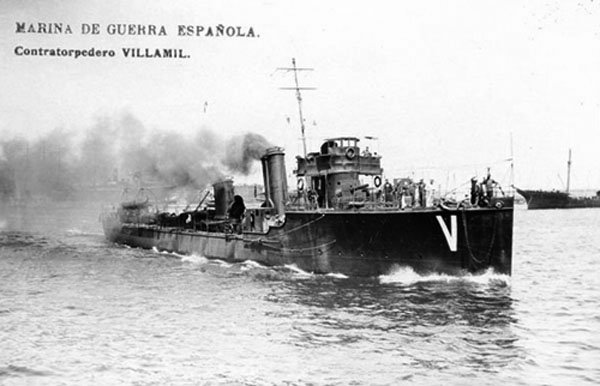
The Bustamante class destroyers comprised three vessel built in Spain, at the S.E.C.N. yard of Cartagena, to a British design, close to the 1903-1905 River class. They were laid down in 1911-1912 and 1913, launched in 1913-14, and completed between 1914 and 1916. They served during the whole interwar, until 1930–1932, only peacetime service in home waters, with the training squadron. When compared to others designs of the time, they were outclassed, both with a light armament and slow.
This class was started after a gap of 18 years… Again, the government look to the Royal Navy for design inspiration. The move was quickstarted in 1908 when the Spanish Cortes passed a Naval Law to make naval dockyards more efficient and able to deliver more modrn ships quicker. A construction programme was also voted, very ambitious, which included two battleships (the future Espana class dreadnoughts), three destroyers, 24 torpedo boats and 4 gunboats. They were all to be completed in 1914, but of course since deliveries depended on UK supplies, construction stalled and most of these prewar designs were completed after the great war, already obsolescent.
To gain time after many years of near-inactivity, all the ships would be built on British designs. The three destroyers were no exception. They were built by Sociedad Española de Construcción Naval (SECN) a newly setup consortium, to refurbish and manage Spanish shipyards, at Cartagena. Consultants came from either Vickers or John Brown, which were part of the SECN consortium.
The new destroyers measured 64.7 metres (212 ft 3 in) by 6.7 m (22 ft 0 in) in beam and 1.7 m (5 ft 7 in) draught, while they displaced 530 long tons (539 t). They were powered by steam turbines by Yarrow and Yarrow or Normand boilers. They were mated on three propeller shafts. The powerplant was rated for 6,250 shaft horsepower (4,660 kW) total. Top speed was 28 knots (52 km/h; 32 mph), and range 900 nautical miles (1,700 km; 1,000 mi) at 15 knots (28 km/h; 17 mph). Armament was very light. It consisted in five Vickers 57 mm (2 in) guns, side-by-side on the ship’s forecastle, aft centreline and on the beam. In addition the Bustamante class carried two banks of two 450 mm (18 in) torpedo tubes.
With the war in Europe, supplies from the UK were cut as the last ship of the bunch was being completed. Cadarso was provisionally equipped with older 380 mm (15 in) torpedo tubes. These delays, added to an already obsolete design, made the the Bustamante class outclassed by contemporary standards, and after a career of neutrality patrols during the war, and as part as a training squadron in the 1920s, they were discarded in 1930, 1931 and 1932. Therefore they are not listed in Spanish WW2 destroyers.
Specifications
Displacement: 380 tonnes FL
Dimensions: 69,8 x 6,88 x 4 m
Propulsion: 2 shafts 3cyl TE engine, 4 Normand Boilers, 7000 hp, 28 knots.
Armament: Two 3-in (75 mm), two 2-in (57 mm), 2 x 8mm Maxim Mgs, two 14-in (350 mm) TT.
Crew: 65
Spanish Destroyers Armament
Due to their size and origin, apart some locally-produced Hontoria guns, the bulk of heavy and light Spanish artillery came from UK, answering to British standards.
Hontoria M1883 L/35 120 mmm (4.7 in): Used on Spanish Torpedo Gunboats
Vickers 3-in (75 mm): Audaz class destroyers
6-pdr (57 mm) Nordenfelt L/45: Same, Audaz and Bustamante class
3-pdr (40 mm) Nordenfelt
25.4 mm L/40 Nordenfelt Heavy MG: Same
8 mm Maxim Machine-gun
14-in (350 mm) Torpedo Tubes on Spanish TGs and Audaz class
18-in (450 mm) Torpedo tubes: Bustamante class
21 in (533 mm) torpedo tubes: Alsedo and Churucca class
WW2 Spanish Destroyers nomenclature
WW2 destroyers in the strict sense were for the most, suviving destroyers of the interwar and the civil war of 1936-39. The WW1 Bustamante class were obsolete in 1930 and scrapped, whereas the Alsedo and Churucca formed the bulk of the destroyer fleet, especially the latter that were on par with British designs of the early 1930s, large and well armed.
Another class was started before WW2, but due to lack of deliveries, armament and subsystems from UK, they were delayed until the end of the war (Audaz class). Also just before WW2, a class of large torped-boats modelled on the French Le Fier class were completed well after the end of the war in 1950. These were 1930s designs in the 1960s.
Alsedo class (1922)
Alsedo, Lazaga, Velasco
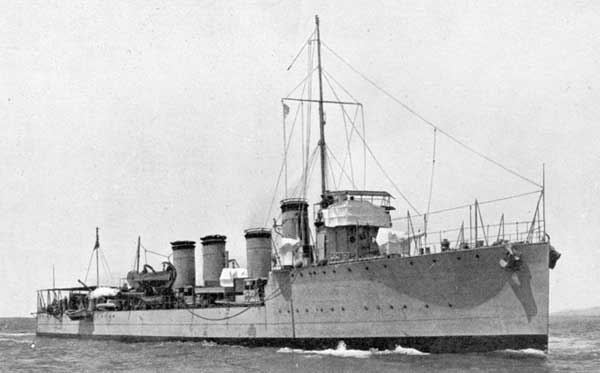
The February 1915 navy law was passed by the Cortes, authorising a large extension of the Armada, notably three destroyers of British design. The camed from the same yard that designed the 1913 M-class destroyer of the prewar emergency program. The Spaniard choosed the Vickers and John Brown layout based on the Hawthorn Leslie variant of the M-class destroyer. Since this was a recent design, the British Director of Naval Construction voiced his objection to pass on another nation such recent design, but could no stop the sale, which proceeded unabated.
The Sociedad Española de Construcción Naval (SECN) dockyard at Cartagena took delivery of the blueprints and starte construction of the three Spanish destroyers, all laid down in 1920, two years after the hostilities stopped and three after the Cortes vote. By that type the M-class has been rendered already obsolete, replaced by the V-W classes.
The Alsedo class measured 86.25 metres (283 ft 0 in) overall or 83.82 metres between parallels, 8.23 metres in beam, and 4.57 metres in draft. Displacement of the ship was 1,060 tonnes (1,043 long tons) standard, and up to 1,336 tonnes fully loaded, a stark difference with the Bustamante class they almost dwarved.
For propulsion they had two geared steam turbines, on two two shafts, with steam provided by four Yarrow water-tube boilers, separated in boilers rooms with their own smokestack. Design speed was 34 knots (63 km/h; 39 mph), quite an improvement over the Bustamante. Alsedo during her sea trials was able to reach 37.2 knots (68.9 km/h; 42.8 mph). By that time she was unarmed however. These Spanish destroyers carried 276 tonnes (272 long tons) of oil, for an autonomy worth of 1,500 nautical miles (2,800 km; 1,700 mi) at 15 knots. They also carried a crew of 86.
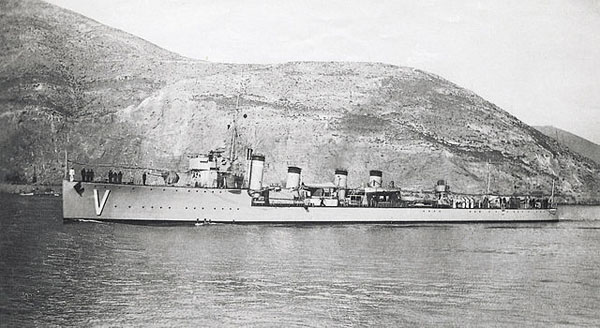
Velasco
The new Spanish destroyer armament was a radical departure of the Bustamante. They carried three of the far more punchy Vickers 4-inch (102 mm) guns. These Vickers designs were built under licence in Spain by Hontoria. They were located one forward on the forecastle, one aft between funnels 2 and 3, and one at the rear. In addition two 47 mm anti-aircraft guns were mounted amidships, later replaced by four 20 mm cannon. In the end two twin 21-inch (533 mm) torpedo tubes were placed on the deck, centerline. They were also quite heavier than the 450 mm of the previous class. In addition, for ASW warfare, they carried two depth charge throwers by 1945 while a more modern rangefinder was installed on her bridge.
Because the war was not over and supplied cut short (already for the Bustamante this caused problems), laying down the keels has been postponed until 1920. Plans to build three more were cancelled eventually, and later a new naval plan asked for more up-to date destroyers, the Churruca class. During the interwar, four 20 mm oerlikon guns were installed, and the old 2-pdr guns removed. They served on the Republican side and survived the war, while Velasco sank the Nationalist B2 (submarine) off Cape Penas (Santander) 19/08/1936.
By 1945 they were given two Deep Charge Throwers and they were stricken in 1957, or 1961.

Lazaga

Author’s rendition of the Alsedo class destroyers
Specifications
Displacement: 1044 standard/1315 tonnes FL
Dimensions: 86,25 x 2,23 x 4,57 m
Propulsion: 2 shafts parsons Turbines engine, 4 Normand/Yarrow Boilers, 33,000 hp, 34 knots.
Armament: Three 4-in (102 mm), two 2-in (47 mm) AA, 2 x 2 21-in (533 mm) TT.
Crew: 86
Churucca class (1926)
Churucca, A. Galiano, S. Barcaiztegui, J.L. Diez, Alm. Ferrandiz, Lepanto, Alm. Valdez, Alm. Antequera, Alm. Miranda, Ciscar, Escaño, Gravina, J. Juan, Ulloa, Alava*, Liniers*
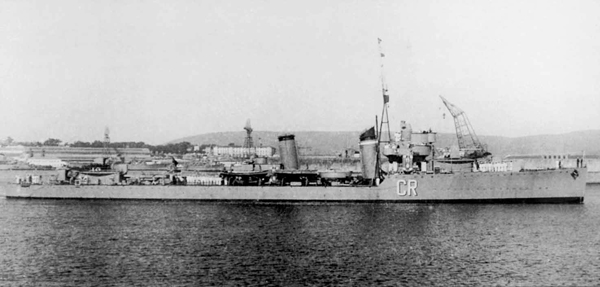
Ciscar
This major class of Spanish destroyers was part of the large naval plan of 1922 and 1930, which were to comprised 8 cruisers, 16 destroyers and 12 submarines. The first early plan on 17 February 1915 by Navy Minister Augusto Miranda y Godoy asked for these destroyers to be simple repeats of the Alsedo class. But there were budget shortcuts, and the decision was delayed several time, until this first option was dropped as the base design was too old.
In the end, the commission in charge of the first group decided to take a new standard, the British Admiralty type flotilla leader of the Scott class design, by then certainly one the best destroyer design in the world. With their standard displacement of 1,560 tonnes, up to 2,120 tonnes fully loaded, 101.50 metres long hull overall, broad beam of 9.68 metres and powerful armament they were a radical departure from Previous Spanish destroyers designs.
When The Churucca class were authorized, fourteen of these as well as 16 submarines were actually completed on the basis of the plans. This destroyer class was so large it was split in three groups. The first had their keels laid down in 1923 while the third group (Alava) was delayed by the Spanish Civil War, World War II, leading to serious redesign and a completion in 1957 as a brand new destroyer class, unique to Spain (see later). The second group ships completed during the Spanish Civil War had no central gun due to the arms embargo imposed on Spain.
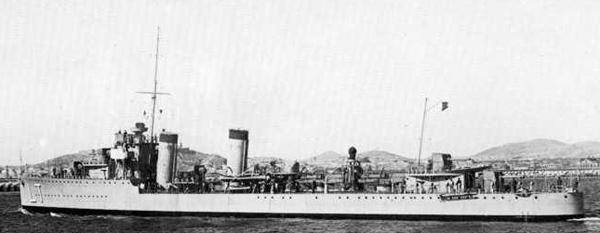
Lepanto
Export Success: ARA Cervantes class
Based on recent “Flotilla Leaders”, with nice classic lines typical of the interwar period between the world wars, excellent speed and powerful armament, these Spanish destroyers were the best ever built in Spain, and among the best in the world when the first group appeared. They were also notably cheaper than the original due to their local constructions and immediately met export successes. At the beginning 14 were planned but 18 destroyers were to be built. Argentina indeed voiced her interest for the class very soon, and ordered some.
While Churruca, Alcalá Galiano and Sánchez Barcáiztegui, were launched between May 1925 and July 1926, there was a good will tour of South America by the Spanish Navy. Accompanied by a Dornier “Wal” Plus Ultra which flew to Buenos Aires with heads of government, two destroyers arrived, the cruiser Méndez Núñez and destroyer Alsedo, on February 7, 1926, which coincided with the modernization of Argentinian forces ad of the Navy.
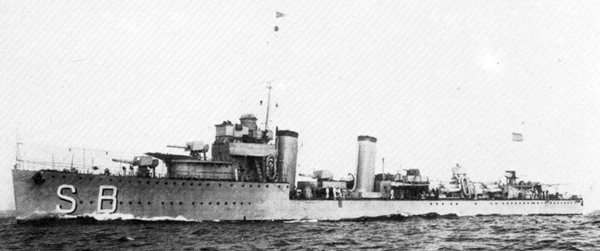
Sanchez Barcaiztegui
During this appropriately timed visit the Spaniards “pre-sold” their (then) new class of destroyers (Alsedo class) while a delegation visited her, and were impressed by her overall quality. In fact the Spanish destroyer, even already of an obsolete design, aroused so much interest in the ARA that a commission was dispatched to Spain, to start negotiations for the construction of a flotilla of similar units. But they were quickly informed of the new class in construction and their interest skyrocketed, followed by orders;
To facilitate the deal, the Spanish government by Royal Decree of May 25, 1927, granted a loan of 100 million pesetas to Argentina when the admiralty expressed interest for the Churruca class. Therefeore the first initially built for the Armada, Churruca and Alcalá Galiano, were sold to the ARA, and renamed Cervantes and Juan de Garay.
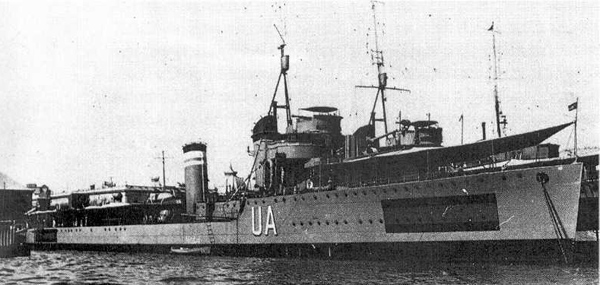
Don Juan de Ulloa
Between 1928 and 1933 the second Churruca and Alcalá Galiano were launched and 5 more, called the first group. The second group would comprise seven more built between 1935 and 1937, financed through savings made from the cancellation of the third heavy cruiser of the Canarias class in Ferrol. The second group was a repeat apparently with no known difference (at least seen in Conway’s), but for their displacement and some details. The 1st group displaced 1536 tonnes, 2087 FL, while the second displaced 1590 tonnes standard, and 2157 fully loaded. No change in armament or performances (but one less main gun, for weight saving or dlivery problems) although the second group carried more fuel, 40 tonnes more to be exact (540 tonnes total).
The second serie however diverged by their reworked and larger bridge and tripod foremast.
Their design was still relevant, as shown by the active service of the Scott class in UK during the war.
Design of the Churruca:
The 100 meters long Churruca (101,98 m) had radically more powerful engines compared to the Alsedo class: They were the first Spanish turbine destroyers, with 4 Yarrow boilers which produced 42,000 hp (31,000 kW) mated on two Parsons turbines, and two shaft propellers. Top speed was 36 knots (67 km/h), with 37-38 knots obtained in speed trials: Churucca (i) made a 4hrs run, reaching an average 37.64kts with spikes to 39.76kts with force heated boilers. Range was 4,500 nmi (8,300 km) at 14 knots (26 km/h) thanks to 480-500 to 540 tonnes of oil. They were also the first oil-burning Spanish destroyers.
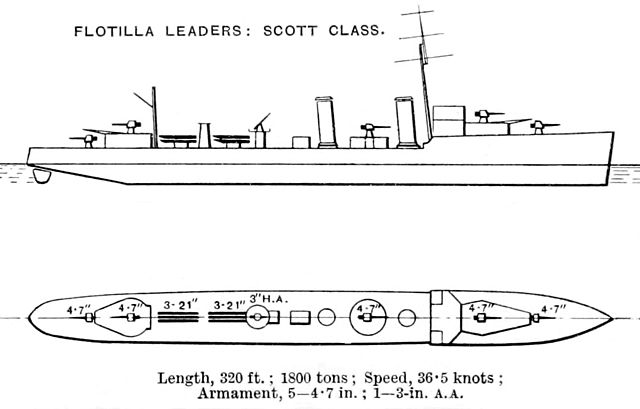
Brassey’s basic design overview of the Scott class
The Churruca class were armed with five 120 mm guns (4.7 in) in pivot mounts with armored masks. Two forward, with ‘B’ mount superfiring and the same configuration aft, plus a central gun amidship. During refits this gun was almost always replaced by more AA guns. The secondary armament comprised a single 76 mm AA gun, two triple banks with 21-in tubes (533 mm), two more than on the Alsedo, and first Spanish destroyers with triple tubes banks, and first with two deep-charge throwers, ASW armament. Thanks to this, these destroyers were able to perform a large array of missions. Armament would change over time. The second group’s completion called for more AA guns notably.
As shown by the Almirante Miranda during WW2, they had only four 120 mm guns, but two 76 mm (3-in) AA guns, one in place of the missing 4.7 in between the funnels, the second placed aft of the second funnel. Other design differences for the 2nd group included modernized main guns, Vickers-Armstrong Mk F 120mm/45 guns with larger shields and reworked pivot mounts (no longer delivered after the 1936 neutrality ban), and a new massive director with a 3m rangefinder. The former model had a 2.74 m span. However none of these directors were received before mid- to late-1939, and replaced by improvised rangefinder posts.
In fact, short supplies started in 1931 with the Revolution, deliveries from San Carlos stalled, and prior to the Civil war, the 2nd series lead vessel Almirante Antequera was delivered without director, and the following missed part of their artillery. San Carlos fell to the Nationalists, and the completion of the 2nd series was improvized by the Republicans with what was available at Cartagena.
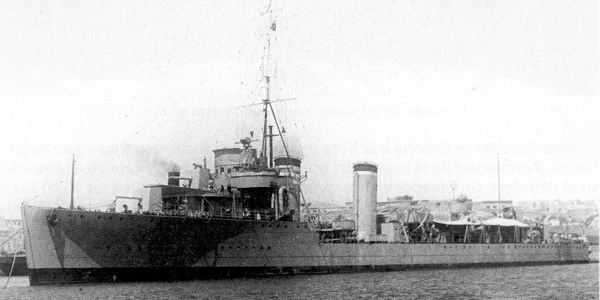
Gravina
Active service
Due to their numbers, the Churucca class destroyers were very active, and most on the Republican side during the civil war. Only one was lost: Almirante Juan Ferrandiz, sunk in September 1936 in the strait of Gibraltar by the Nationalist cruiser Canarias. José Luis Diez was badly damaged by the Canarias or minelayer Vulcano but managed to be beached at Catalon Bay on 30 December 1938, refloated and towed to Gribraltar to be repaired, and interned by the British authorities until the end of the war.
Ciscar (last ship of the 2nd group) was sunk in shallow waters by Nationalist aviation at Gijon on 21 October 1937, but she was later refloated by the Nationalists, repaired and pressed into service before the end of the civil war, one of the rare Destroyers used by the Nationalists. Alcalá Galiano collided on 11/6/1937 with the cargo Magallanes whereas Churucca was torpedoed by the Italian submarine Jalea off Cartagena 12/8/1937 but she managed to limp back to port and was repaired, but never returning into service as the Galiano. Both were disarmed as the Republican front needed artillery and they stayed idle until the end of the war. They had been further damaged by other air raids in between and repairs were only partial. Sánchez Barcáiztegui, already repaired was definitely lost to air-dropped bombs.
The most famous action was performed by three of these destroyers, torpedoed and sank the Cruiser Baleares. Sanchéz Barcáiztegui, Lepanto, and Almirante Antequera indeed torpedoed the heavy cruiser at night, at around 02:30 AM. The cruiser was hit by a volley of torpedoes, which cut the hull in half and she sank rapidly. This happened at the battle of the Cape Palos (05-06.04.1938), and this was the greated success of the Republican Navy during this war.
On 5 march 1939, the Remaining 8 destroyers fled the surrounded Cartagena to Bizerte, arriving on the 8 march. They were interned by French and later transferred to the new Nationalist government on 31 march. They served in WW2, making only neutrality patrols. Before WW2 they received additional armaments: 25 mm/60 M1938 guns, 40 mm/39 QF Mk II and 20 mm/70 Oerlikon M36 AA guns, sometimes a single 102mm/50 to replace the missing 120 mm (2nd serie). During WW2, Almirante Valdés, Almirante Antequera, Almirante Miranda, Gravina, Escaño, Císcar, Jorge Juan, Ulloa: were given extra AA guns, two twin German FLAK 37 mm/80 SK C/30, and four 20mm/65 C/38, plus four DCTs instead of two.
The Churruca Spanish destroyers served also during the cold war, to be discarded in the 1960s, re-equipped with radars and sonars in the 1950s. Ciscar was lost on rocks at El Ferrol on 17 october 1957. The modified 3rd serie ships served for much longer, until 1980. By then, this 1918 design was hopelessely outdated.
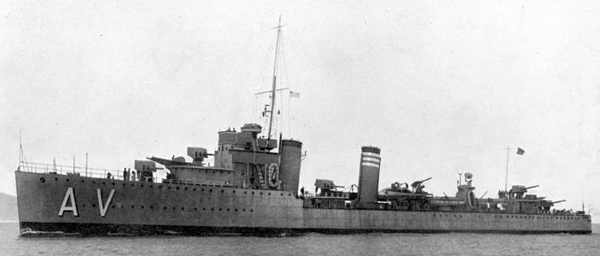
Almirante Valdes
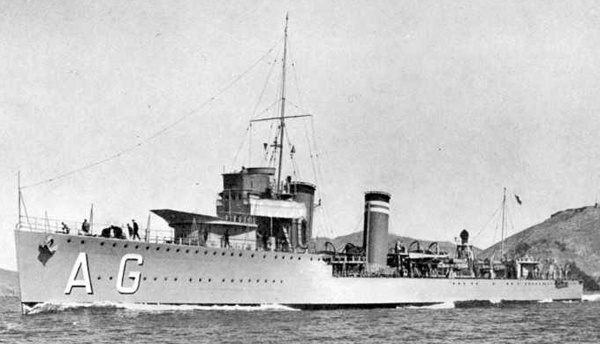
Alcala Galiano. She was the hero of the battle of 05 august 1936, tryinfg to intercept the Nationalist vitoria convoy sailing from Ceuta. She engaged the convoy, but was repelled by aviation. Later the Republican gunboat Dato fired on the very similar HMS Basilisk by Mistake, trigerring a diplomatic incident. Alcalá Galiano was attacked several times by aviaton on her way back and badly damaged.
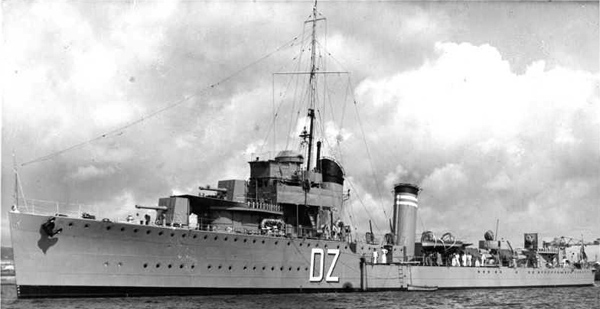
Jose Luis Diez (order decree from 31/3/1926, completed Sept. 1929). She was part of the 1st group, with a slighty more angled prow (102.0 oa overall lenght), 480 to 500 tonnes of oil, five 120 mm/45 guns and a single 76/45 Vickers Mk SS AA. She definitely ws the mosyt battle-hardened of all, duelling on 27/8/1938 off Gibraltar with the heavy cruiser Canarias, interned in Gibraltar. Fled on 30/12/1938 only to duel with the minelayer Vulcano and running aground, salvaged next day, to be towed off back to Gibraltar and this time interned under strong guard, until the end of the war.

Author’s rendition of the Churruca class destroyers
Specifications
Displacement: 1536/1590 standard/2087/2175 tonnes FL
Dimensions: 97,52/101,50 x 9,68 x 3,20 m
Propulsion: 2 shafts parsons Turbines engine, 4 Yarrow Boilers, 42,000 hp, 36 knots.
Armament: Five 5-in (120 mm), One 3-in (76 mm) AA, four MGs, six 21-in (533 mm) TTs, two DCTs.
Crew: 175
CEUTA class (ex-Italian Aquila class, tr. 1938)
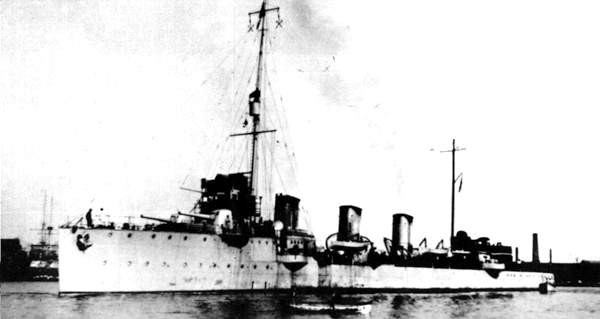
The Spanish Republicans at the start of the civil war possessed all the destroyers of the Alsedo and Churucca class, whereas the Nationalists captured major ships but lacked a suitable escort (outside gunboats). Soon Fascist Italy came to the rescue and in 1938 decided to send four old lead destroyers dating back from WW1: Those of the Aquila class, three-funneled. These were the Aquila, Falco, Gugliemo Pepe, Alessandro poerio, renamed in Spanish service Ceuta, Melilla, Huesca and Teruel, without any change in armament and letter paintained on the hull for identification. They served for a short time without much event and were back in Italian hands, to be resold to the Romanians.
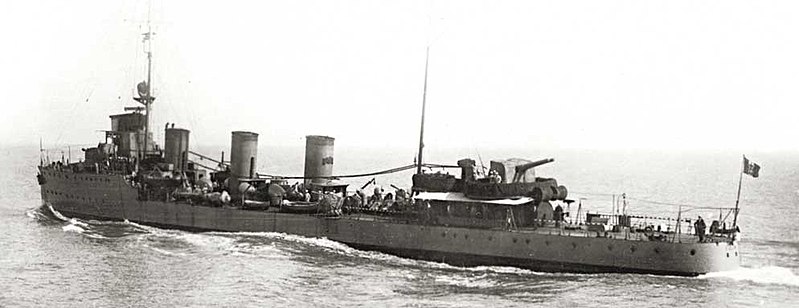
Stern of the Aquila in Romanian service as Mărăști in WW2
Characteristics
Same as the Italian Aquila class
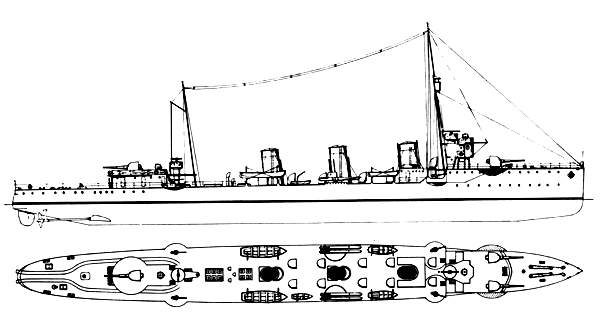
Profile scheme of the Esploratori Aquila
Liniers class (1936-47)
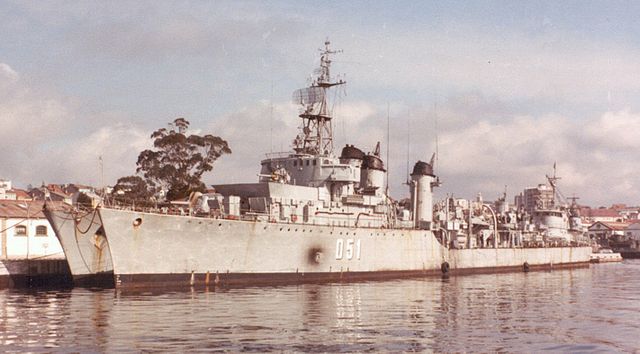
The third group
In 1936 the first two of the third group was laid down but construction was soon widely affected by the start of the Spanish Civil War. The lack of funds and material made it stall and delayed until 1939, then started over timidly to be immediately stopped again due to the second world war breaking up and the same supply problems happening again. It was decided to resume work in 1943 since Argentina expressed the will to purchase one, and the admiralty used this as an incentive to complete the others, as the export would finance them. In 1944, however the Argentine Government eventually declined the order, preferring other options (like waiting to purchase surplus USN destroyers after the war, or British ones).
They would however express their interest for a purchase only if the destroyers saw their construction completed in 1951. This third group of course could no longer be a simple repeat of the 1918 Scott class, now totally obsolete. The design had a profound modernization dictated by foreign designs study, but on the same basis. They would form the Liniers class (see below), and were actually larger, with a beam of 3.7 m, and displacement of 2225 tonnes FL, larger crew and modernized armament, reworked superstructures.
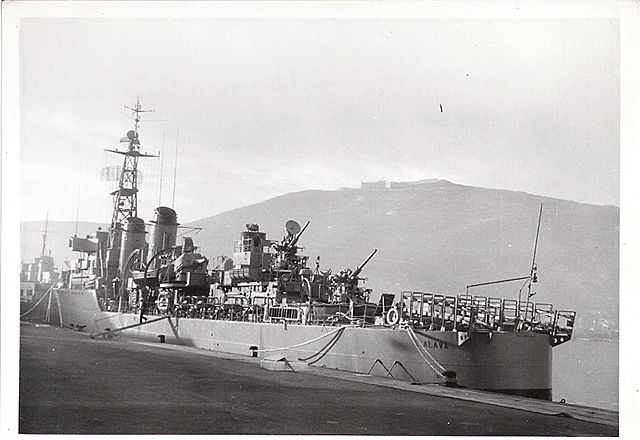
Alava (D52), aft view
Alava and Liniers were laid down in 1936, suspended, laid down again in 1939, suspended again, and at least restarted at Cartagena in 7/1/1944 and January 1945 with a few designs changes.
They were launched on 18/5/1947 but completion was delayed as their design was outmoded. They were completed in January and December 1951 to a heavily modified design. Basically the greatest changes were the ommission of the fifth 120 mm gun, redesigned gun shields, three twin German 37 mm AA guns and three single 20 mm guns, placed between and aft the funnels. The greates change was the fitting of two quadruple banks of torpedoes. The tripod mast was larger and the bridge superstructure modified. The initial 1945 design planned for two win 25 mm AA while the 120 mm had a new 45° dual-purpose mount.
In 1960-1962 both Álava and Liniers were drastically reconstructed as ASW frigates. They had a new lattic masts with radars, longer prow, MLA-1B, SG-6B, Decca TM626, two Mk 63 radars, one SQS-30A sonar, and were armed with three DP 76mm/50 Mk 34, three 40mm/70 SP48, two triple ASW 324 mm torpedo tube banks, two 24-barrels (178 total) Hedgehog Mk 11 ASWRLs and eight DCTs plus two DCRs. They served until 1978 and 1980s respectively, amazing for ships which were based on a 1917 blueprint (The scott class leaders).
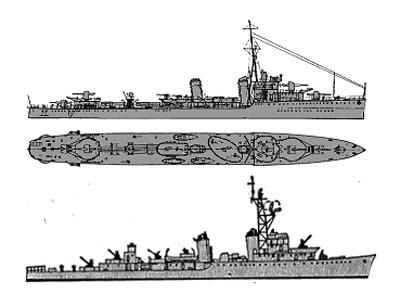
Evolution of the design (src navypedia): 1951 and 1962 as ASW frigates.
More on a future post. Scr 1, 2
Audaz class Destroyers (TBs) (1945)
Ariete, Artevida, Audaz, Furor, Intrepido, Osado, Rayo, Relampago, Temerario.
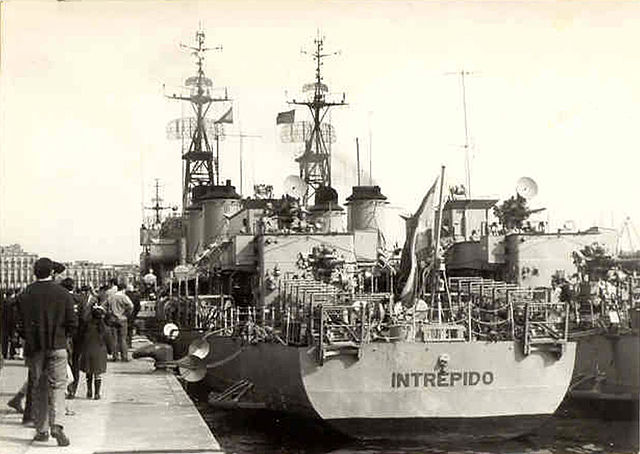
Intrépido in La Coruña, 1966.
In 1945, the Spanish admiraly was granted onstruction of a class of nine small destroyers (torpedo boats for Conway’s), based on the French Le Fier class torpedo boat design. Seven were laid down in 1939–1940 but as the French surrendered in 1940, construction was stopped and although Germany restarted six of them, rearmed with German AA and main guns armament, none were completed amidst sabotage, labor and materials shortages. Meanwhile Spanish ships were to used the same armament layout as the German ships.
The class was laid down in July-August by the Sociedad Española de Construcción Naval (SECN) shipyard at Ferrol. None was completed before 1953. D37 and 39, the last two, were even completed in 1964 but discarded immediately, in 1964-65, and taken in hands for a reconstrcution. By 1955 all were reclassed as ASW frigates and the first four were completed in 1955 with a modified design, the last with a very different armament. More on these on the coldwar Spanish Page (in writing, to be released soon).
Oquendo class (project, 1945)
Oquendo, Roger de Lauria, Marqués de la Ensenada
These cold war destroyers are listed here because initially it was provisioned in 1943 with the order for nine ships. In the end, with the usual delays during WW2 only three ships were laid down at SECN, and the six would have been “Blas de Lezo”, “Gelmírez”, “Lángara”, “Bonifaz”, “Recalde”, and “Blasco de Garay”. They were cancelled, and reordered again in 1947-48 to a modified design. Initially, they were very much inspired by the US Gearing class destroyers and were armed with the same three twin standard 4.7 in DP turrets, but not a flush-deck hull, but instead a lower aft deck.
The powerplant was to be from Rateau-Bretagne in France but deliveries were much delayed and the first ship was launched not until 1959, 15 years after initial procurement. These made them already obsolescent as missile destroyers were in construction. As a result, only three ships, Oquendo, Roger de Lauria, and Marqués de la Ensenada were delivered, which had a short active life, discarded in 1978-88. more on the cold war Armada page.
Read More/Src
//www.kbismarck.com/mgl/destruc.htm
//www.revistanaval.com/www-alojados/armada/batallas/palos.htm
//www.navypedia.org/ships/spain/sp_dd.htm
//www.navypedia.org/ships/spain/sp_dd_churucca.htm
//es.wikipedia.org/wiki/Clase_Oquendo
//www.kbismarck.org/churruca3-destroyers.html
//en.wikipedia.org/wiki/Audaz-class_destroyer
//todoavante.es/index.php?title=Lazaga_(1925)
//en.wikipedia.org/wiki/List_of_retired_Spanish_Navy_ships
//www.wikiwand.com/es/Anexo:Destructores_de_la_Armada_de_Espa%C3%B1a
//en.wikipedia.org/wiki/List_of_retired_Spanish_Navy_ships
//www.shipmodell.com/index_files/0PLAN5C.html#5S


 Latest Facebook Entry -
Latest Facebook Entry -  X(Tweeter) Naval Encyclopedia's deck archive
X(Tweeter) Naval Encyclopedia's deck archive Instagram (@navalencyc)
Instagram (@navalencyc)





 French Navy
French Navy Royal Navy
Royal Navy Russian Navy
Russian Navy Armada Espanola
Armada Espanola Austrian Navy
Austrian Navy K.u.K. Kriegsmarine
K.u.K. Kriegsmarine Dansk Marine
Dansk Marine Nautiko Hellenon
Nautiko Hellenon Koninklije Marine 1870
Koninklije Marine 1870 Marinha do Brasil
Marinha do Brasil Osmanlı Donanması
Osmanlı Donanması Marina Do Peru
Marina Do Peru Marinha do Portugal
Marinha do Portugal Regia Marina 1870
Regia Marina 1870 Nihhon Kaigun 1870
Nihhon Kaigun 1870 Preußische Marine 1870
Preußische Marine 1870 Russkiy Flot 1870
Russkiy Flot 1870 Svenska marinen
Svenska marinen Søværnet
Søværnet Union Navy
Union Navy Confederate Navy
Confederate Navy Armada de Argentina
Armada de Argentina Imperial Chinese Navy
Imperial Chinese Navy Marinha do Portugal
Marinha do Portugal Mexico
Mexico Kaiserliche Marine
Kaiserliche Marine 1898 US Navy
1898 US Navy Sovietskiy Flot
Sovietskiy Flot Royal Canadian Navy
Royal Canadian Navy Royal Australian Navy
Royal Australian Navy RNZN Fleet
RNZN Fleet Chinese Navy 1937
Chinese Navy 1937 Kriegsmarine
Kriegsmarine Chilean Navy
Chilean Navy Danish Navy
Danish Navy Finnish Navy
Finnish Navy Hellenic Navy
Hellenic Navy Polish Navy
Polish Navy Romanian Navy
Romanian Navy Turkish Navy
Turkish Navy Royal Yugoslav Navy
Royal Yugoslav Navy Royal Thai Navy
Royal Thai Navy Minor Navies
Minor Navies Albania
Albania Austria
Austria Belgium
Belgium Columbia
Columbia Costa Rica
Costa Rica Cuba
Cuba Czechoslovakia
Czechoslovakia Dominican Republic
Dominican Republic Haiti
Haiti Hungary
Hungary Honduras
Honduras Estonia
Estonia Iceland
Iceland Eire
Eire Equador
Equador Iran
Iran Iraq
Iraq Latvia
Latvia Liberia
Liberia Lithuania
Lithuania Mandchukuo
Mandchukuo Morocco
Morocco Nicaragua
Nicaragua Persia
Persia San Salvador
San Salvador Sarawak
Sarawak Uruguay
Uruguay Venezuela
Venezuela Zanzibar
Zanzibar Warsaw Pact Navies
Warsaw Pact Navies Bulgaria
Bulgaria Hungary
Hungary

 Bundesmarine
Bundesmarine Dutch Navy
Dutch Navy Hellenic Navy
Hellenic Navy Marina Militare
Marina Militare Yugoslav Navy
Yugoslav Navy Chinese Navy
Chinese Navy Indian Navy
Indian Navy Indonesian Navy
Indonesian Navy JMSDF
JMSDF North Korean Navy
North Korean Navy Pakistani Navy
Pakistani Navy Philippines Navy
Philippines Navy ROKN
ROKN Rep. of Singapore Navy
Rep. of Singapore Navy Taiwanese Navy
Taiwanese Navy IDF Navy
IDF Navy Saudi Navy
Saudi Navy Royal New Zealand Navy
Royal New Zealand Navy Egyptian Navy
Egyptian Navy South African Navy
South African Navy






























 Ukrainian Navy
Ukrainian Navy dbodesign
dbodesign